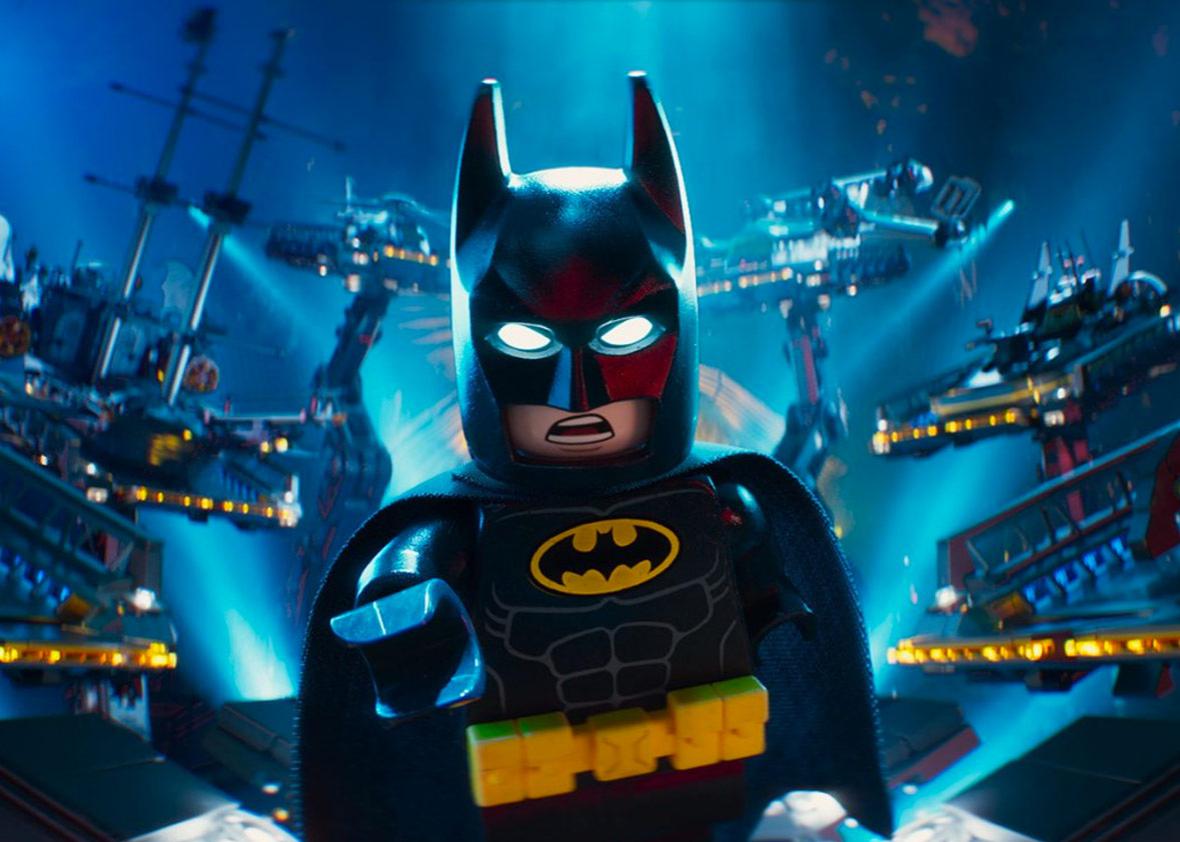The first 40-odd minutes of The Lego Batman Movie are exactly what you want them to be: a dense, hilarious spoof of Batman, superheroes, and the clenched idea of masculinity that informs them. Will Arnett’s Dark Knight is a preening braggart with a fragile ego who basks in public adulation then returns to his mansion to eat microwaved lobster and watch Jerry Maguire alone. There are winking references to 80-odd years of Batman history, but they’re all in service to a coherent, plausible, and profoundly unsympathetic portrayal of the character. For the duration of that joke-packed first act, it’s possible to believe that the miracle of The Lego Movie is repeating itself.
That 2014 phenomenon sprung from the unusually deep thematic tension at the heart of Lego (a brand described by some experts, implausibly, as “the world’s most powerful”): the opposition between making a cool, imaginative structure through the improvisatory agglomeration of blocks and making an intricate model of the Millennium Falcon by following the instructions. Lego is a brand that is increasingly tied up in its own ambivalent relationship to other brands and to the way in which corporate-owned intellectual-property franchises are colonizing increasingly vast swaths of human consciousness. This thematic opposition, extraordinarily, was at the crux of The Lego Movie, which, in its casual smashing together of figures from across the pop monoculture, felt like actual childhood play. It went so deep into the Hellmouth of licensing that its head emerged, smiling cheerfully, on the other side. It was less a story than a jailbreak.
Batman, the breakout character of The Lego Movie, has a dialectic of his own: He’s a fascist, and like all fascists, he periodically crosses the line into camp. (For every brooding Tim Burton goth opus, there’s a Joel Schumacher to come along and draw nipples on the costume.) The Lego Movie’s refreshingly contemporary insight into the Caped Crusader was that a man who’d spent his life striving to achieve physical and mental perfection in order to perform solitary acts of redemptive violence would almost certainly be a narcissistic asshole. Having had that insight (and having secured permission from the Time Warner licensing czars to deploy it), the movie had the wit to position Batman not as the protagonist but as a romantic rival to its regular-Joe hero. Lego Batman was an asshole at the beginning of The Lego Movie and an asshole at the end, and the movie’s love plot was basically “How can we get him out of the way?”
The Lego Batman Movie can’t do that because, by law, every movie has to have a protagonist who goes through an emotional arc, even a movie about Batman in which Batman is made out of Lego. Which is why that genuinely hilarious first act degenerates into a by-the-numbers superhero movie in which Lego Batman finally learns to shed his defensive exterior and open himself up to the people who care about him. The overplotted second act revolves around “the Phantom Zone,” a giant portal in the sky. Maybe this is a joke about how every superhero movie now revolves around a giant portal in the sky, but if so, it’s an extremely subtle joke, and you’re still watching a boring-ass movie about a giant portal in the sky.
And throughout, many of the incidental pleasures from Phil Lord and Chris Miller’s original film are diminished. (The writer-directors are replaced here by Robot Chicken’s Chris McKay and a five-man committee of comedy writers.) The animation looks less like a meticulously staged CGI recreation of the stop-motion “brickfilm” aesthetic and more like an ordinary digital cartoon. Meanwhile, the performances, apart from Arnett’s reliable Christian Bale impression and Michael Cera’s winsome Robin, feel rushed. (I have no idea what Zach Galifianakis was going for as the Joker, besides a paycheck.)
But the greatest disappointment is how much of the script seems to have been assembled from a kit by someone afraid to deviate from the instructions. In a sequel to The Lego Movie, that’s not just a letdown, it’s a betrayal.
